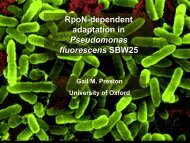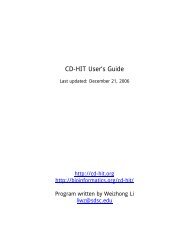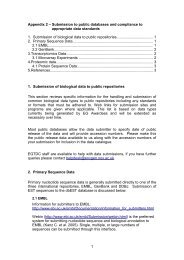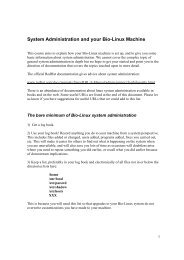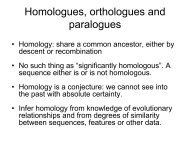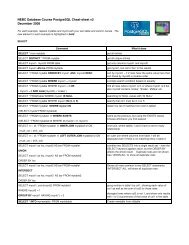The genomics of plant-virus co-evolution in wild Brassica species
The genomics of plant-virus co-evolution in wild Brassica species
The genomics of plant-virus co-evolution in wild Brassica species
You also want an ePaper? Increase the reach of your titles
YUMPU automatically turns print PDFs into web optimized ePapers that Google loves.
<strong>The</strong> <strong>genomics</strong> <strong>of</strong> <strong>plant</strong>-<strong>virus</strong><br />
<strong>co</strong>-<strong>evolution</strong> <strong>in</strong> <strong>wild</strong> <strong>Brassica</strong><br />
<strong>species</strong><br />
Mike Kearsey<br />
Agriculture and<br />
Agri-Food Canada<br />
Environmental Genomics Grant Number NER/T/S/2002/00902<br />
1
Questions.<br />
• Do <strong>wild</strong> <strong>plant</strong>s show a different genetic response<br />
to local <strong>virus</strong> pathotypes than to foreign ones<br />
• Is there <strong>co</strong>mpetition between different <strong>virus</strong><br />
pathotypes replicat<strong>in</strong>g with<strong>in</strong> a s<strong>in</strong>gle <strong>plant</strong> and<br />
does the out<strong>co</strong>me depend on <strong>plant</strong> genotype<br />
• Do these effects vary with <strong>plant</strong> <strong>species</strong><br />
2
Transcriptomics Approach.<br />
2. To develop and optimise an oligonucleotide<br />
microarray to study <strong>Brassica</strong> <strong>genomics</strong> <strong>in</strong><br />
order to…..<br />
4. … identify genes <strong>in</strong>volved <strong>in</strong> differential <strong>plant</strong><br />
host responses to challenge from different viral<br />
genotypes.<br />
3
Experimental System:<br />
Plant <strong>co</strong>mmunities & <strong>virus</strong> isolate orig<strong>in</strong><br />
Turnip Mosaic Virus<br />
(TuMV)<br />
Llandudno, Wales<br />
<strong>Brassica</strong> oleracea<br />
& TuMV GBR83<br />
• Poty<strong>virus</strong>, s<strong>in</strong>glestranded<br />
+ sense RNA<br />
genome (10K bp)<br />
W<strong>in</strong>spit, Dorset<br />
<strong>Brassica</strong> oleracea<br />
& TuMV GBR98<br />
Culham, Oxon<br />
<strong>Brassica</strong> rapa<br />
Sturm<strong>in</strong>ster Newton, Dorset<br />
<strong>Brassica</strong> rapa<br />
4
Genetic variation – TuMV <strong>co</strong>at<br />
100<br />
100<br />
100<br />
prote<strong>in</strong> nucleotide sequence<br />
2 - 4 major phylogenetic<br />
groups supported by high<br />
bootstrap values<br />
<strong>The</strong> genetic diversity <strong>of</strong><br />
W<strong>in</strong>spit, Dorset<br />
sub-populations Chapman‘s Pool, Dorset is partially<br />
Kimmeridge, Dorset<br />
def<strong>in</strong>ed Great by Orme, the Walesgeographic<br />
Staithes,<br />
location<br />
North Yorkshire<br />
GBR 48(S)<br />
GBR 47(S)<br />
100<br />
GBR 98(W)<br />
GBR 44(W)<br />
GBR 43(W) GBR 98<br />
GBR 38(W) Pathotype 1<br />
GBR 36(W)<br />
GBR 37(W)<br />
GBR 23(C)<br />
GBR 31(C)<br />
GBR 18(K)<br />
GBR 21(W)<br />
GBR 29(C)<br />
GBR 19(C)<br />
GBR 35(W)<br />
GBR 32(C)<br />
GBR 28(C)<br />
UK 1<br />
UK2<br />
1<br />
GBR 56(GO)<br />
GBR 26(K)<br />
GBR 27(K)<br />
GBR 25(K)<br />
GBR 24(K)<br />
GBR 20(K)<br />
GBR 30(K)<br />
GBR 91(GO)<br />
GBR 22(C)<br />
GBR 46(S)<br />
GBR 49(S)<br />
GBR 50(S)<br />
GBR 45(S)<br />
GBR 57(GO)<br />
GBR 53(GO) 2<br />
GBR 52(GO)<br />
GBR 51(S)<br />
GBR 55(GO)<br />
GBR 54(GO)<br />
GBR 83(GO)<br />
GBR 83<br />
Pathotype 3<br />
3<br />
5<br />
4
Results from 1 st <strong>co</strong>mpetition experiment<br />
Wild cabbage from Llandudno (LL3);<br />
local isolate is GBR 83<br />
number <strong>of</strong> <strong>plant</strong>s<br />
8<br />
7<br />
6<br />
5<br />
4<br />
3<br />
2<br />
1<br />
0<br />
B. napus – susceptible <strong>co</strong>ntrol<br />
Inoculation 1st round 2nd round 3rd round 4th round 5th round<br />
mixed <strong>in</strong>fected<br />
Infected with GBR 98 from W<strong>in</strong>spit<br />
Infected with GBR 83 from Llandudno<br />
number <strong>of</strong> <strong>plant</strong>s<br />
Wild cabbage from W<strong>in</strong>spit (WS15);<br />
local isolate is GBR 98<br />
number <strong>of</strong> <strong>plant</strong>s<br />
8<br />
7<br />
6<br />
5<br />
4<br />
3<br />
2<br />
1<br />
0<br />
8<br />
7<br />
6<br />
5<br />
4<br />
3<br />
2<br />
1<br />
0<br />
Inoculation 1st round 2nd round 3rd round 4th round 5th round<br />
Inoculation 1st round 2nd round 3rd round 4th round 5th round<br />
6
<strong>Brassica</strong> Array / Sub-array Layout - Schematic<br />
15,000 oligos spotted <strong>in</strong> duplicate<br />
-14,996 <strong>Brassica</strong> napus<br />
- 4 TuMV<br />
26<br />
12<br />
26<br />
4<br />
Land<strong>in</strong>g light<br />
Stratagene Alien Oligo Controls<br />
676<br />
Oligos duplicated with<strong>in</strong> a subarray<br />
7
Why create a <strong>Brassica</strong> array<br />
<strong>Brassica</strong>s closely related to Arabidopsis,<br />
BUT:<br />
• <strong>Brassica</strong>s are ancient polyploid <strong>species</strong><br />
so need to dist<strong>in</strong>guish between multiple<br />
members <strong>of</strong> related gene families.<br />
• B.napus chip has both A and C genomes.<br />
• Many <strong>Brassica</strong> genes would not be<br />
represented on an Arabidopsis array.<br />
8
Gene Families Arrayed.<br />
Enriched for:<br />
• Stress (biotic and abiotic)<br />
• Meiosis and reproduction<br />
• Genes re<strong>co</strong>gnisable <strong>in</strong> Arabidopsis<br />
• Genes with no Arabidopsis equivalent.<br />
Avoided:<br />
• Housekeep<strong>in</strong>g and ribosomal genes<br />
9
Experimental design<br />
for each population/<strong>species</strong>.<br />
Mock<br />
(n <strong>plant</strong>s)<br />
X r slides<br />
X r slides<br />
TuMVGBR83<br />
(n <strong>plant</strong>s)<br />
X r slides<br />
TuMV GBR98<br />
(n <strong>plant</strong>s)<br />
10
Results – Quantitative analysis<br />
Genes Differentially Expressed<br />
Mock vs. 83<br />
Mock vs. 98<br />
83 vs. 98<br />
B. rapa - Culham<br />
1107<br />
1199<br />
656<br />
B. rapa – Stur. Newt<br />
762<br />
615<br />
362<br />
B. oleracea - Llandudno<br />
141<br />
103<br />
1<br />
B. oleracea - W<strong>in</strong>spit<br />
30<br />
29<br />
1<br />
11
Results – Qualitative analysis<br />
• GO analysis:<br />
1. Biological Processes - describes what it changes<br />
2. Molecular Function – describes what it does<br />
3. Cellular Component – describes where it acts<br />
• GOSSIP: uses GO annotations to test whether terms<br />
are enriched with<strong>in</strong> a group <strong>of</strong> genes <strong>co</strong>mpared to a<br />
reference set.<br />
12
GO Analysis - Highlights<br />
Significant<br />
GO Terms<br />
Photosystem II<br />
/Thylakoid<br />
Proteolysis<br />
Biological significance<br />
Known to be down-regulated <strong>in</strong><br />
several <strong>plant</strong>-<strong>virus</strong> systems<br />
Fungal attack causes degradation<br />
<strong>of</strong> unnecessary prote<strong>in</strong>s<br />
Oxidative<br />
stress<br />
Water<br />
deprivation<br />
Known <strong>plant</strong>-resistance related pathways<br />
Useful markers for programmed<br />
cell death (PCD)<br />
L<strong>in</strong>k to environmental <strong>co</strong>nditions<br />
and possible explanation for<br />
TuMV’s absence <strong>in</strong> <strong>wild</strong> B.rapa<br />
14
GO Analysis<br />
Significant<br />
GO Terms<br />
Carbon<br />
utilisation<br />
Nucleosome<br />
&<br />
Nucleosome<br />
assembly<br />
Biological significance<br />
Culham <strong>plant</strong>s down-reg these<br />
genes <strong>in</strong> response to both<br />
isolates. Not significant <strong>in</strong><br />
Sturm<strong>in</strong>ster Newton<br />
Both are related terms <strong>in</strong> two<br />
separate ontologies. Significant<br />
difference between isolates:<br />
83 up-regulated w.r.t 98;<br />
detected <strong>in</strong> both <strong>plant</strong> pops.<br />
15
Summary<br />
• We developed a 15K <strong>Brassica</strong> oligo array<br />
to analyse gene expression <strong>of</strong> three related<br />
<strong>Brassica</strong> <strong>species</strong>.<br />
• We detected ~10-fold greater expression <strong>in</strong><br />
<strong>wild</strong> B. rapa than B.oleracea <strong>in</strong> response to<br />
two TuMV isolates.<br />
• GO analysis suggests that many genes<br />
detected are <strong>in</strong>volved <strong>in</strong> fail<strong>in</strong>g B. rapa<br />
resistance pathways and PCD.<br />
16
CEH Oxford:<br />
Acknowledgements<br />
Jono Reeves, Denise Pallett, Hui Wang, Ian<br />
Cooper, Bela Tiwari, Delia McCall.<br />
HRI Warwick:<br />
John Walsh, Christian Obermeier.<br />
University Of Birm<strong>in</strong>gham:<br />
Rachel Machado, Zewei Luo, Ela<strong>in</strong>e Howell.<br />
Agriculture and Agri-food Canada:<br />
Andrew Sharpe, Derek Lydiate, Branimir<br />
Gretvaj, Chris Lewis<br />
17






